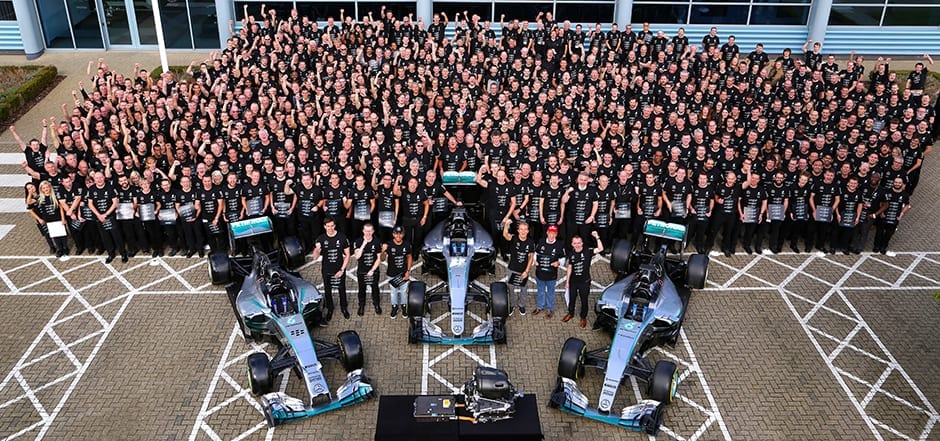Above: Mercedes AMG celebrates yet another F1 championship success for its engines
[title size=”4″]An established motorsport industry is at the core of the East Midlands’ advanced manufacturing clusters, including medical technology, pharmaceuticals agricultural robots – and Doc Martin’s shoes. By Charles Orton-Jones.[/title]
- ‘Motorsport Valley’: 4300 businesses, 41,000 staff, £9bn in worldwide sales and sky-high R&D levels
- National Centre for Food Manufacturing in Holbeach set to become epicentre of food tech in the UK
- Nottingham’s BioCity is a valuable incubator for pharma companies
- Dr Marten’s profits reach £37.5m [/content_box]
[/content_boxes]
[title size=”2″]High revs, high performance[/title]
Neighbouring villages have similar stories to tell, sitting as they do in the orbit of Silverstone race track. In the east of the county is the Rockingham Motor Speedway Circuit. A few miles south is the Santa Pod drag racing strip. Mallory Park and Donington Park racetracks are within a few miles. ‘Motorsport Valley’ radiates 80 miles from Silverstone in all directions; 4300 businesses, with 41,000 staff and £9bn in worldwide sales, are to be found in the region. R&D levels are sky high: up to 30 percent of total turnover.
It’s the perfect example of a worldclass technology cluster. When Aston Martin, located in the village of Gaydon, Northants, needed a new engine for its Valkyrie hypercar project, designed by F1 legend Adrian Newey, it picked Cosworth to build the 6.5-litre V12 engine. Any why not? Cosworth is the best in the world at this sort of stuff, and just 10 minutes up the road in Northampton. Moving from high-performance to heavyweight performance, JCB Power Systems in Foston, on the other side of Birmingham, celebrated the production of its 500,000th engine at the end of 2017.
[title size=”2″]Food for thought – and health[/title]

(Credit: BioCity Nottingham)
Each county in the East Midlands boasts a unique manufacturing strength. Lincolnshire is focusing on the technology of agriculture.
Brexit is helping: after departure from the EU, who will pick the potatoes? The University of Lincoln Institute of Agri-food Technology (LIAT) is developing a fleet of robots to do the work. A fully-automated robot vehicle uses softtouch arms to pluck broccoli from the field. The unit is modelled on the Mars Rover. The LIAT Thorvald, a soil-sampling vehicle, is part of the drive to use sensors and data modelling to enhance yields. The National Centre for Food Manufacturing in Holbeach, Lincolnshire, will soon be seen as the epicentre of food tech in the UK.
In Nottingham, the focus is on life sciences. In 2001, German materials company BASF made a huge donation of 129,000 square feet of office space to Nottingham Trent University (NTU), which responded by partnering with the University of Nottingham to create BioCity, an incubator for pharma companies. Start-ups get easy access to lab equipment such as mass spectrometers and rotary evaporators. Residents include Azotic Technologies, which is developing nitrogen fixing technologies as a way to reduce dependence on fertilizer, and blood coagulant company Haemostatix, which deals with the control of bleeding during surgery.
[images lightbox=”yes”]
[image link=”” linktarget=”_self” image=”https://ukmfgreview.com/2017/wp-content/uploads/sites/11/2018/01/2017-06-17-Robot-Tractor-Front-3-Quarter-Render-01.jpg” alt=”Performance Projects – Dymium agricultural robot”]
[image link=”” linktarget=”_self” image=”https://ukmfgreview.com/2017/wp-content/uploads/sites/11/2018/01/Thorvald-University-of-Lincoln.jpg” alt=”LIAT Thorvald soil-sampling vehicle. Credit: University of Lincoln Institute of Agri-food Technology (LIAT)”]
[/images]
[title size=”2″]Diversity is strength[/title]
“It’s the diversity of the East Midlands that is its strength,” says Charlotte Horobin, East Midlands director of the EEF. “There’s great work being done all over the region.
The latest market data is highly encouraging. “Recruitment intentions are good. Investment intentions are positive, and exports are positive.” The only downside is a sense that performance could be even higher. “We’d like to see more investment in new technology, new plants and new equipment.”
A spur may come from investors as they discover the opportunities hidden around the region. For example, the shoe industry is booming, thanks to well-funded buyers. Church’s Shoes is expanding globally under the guidance of Prada, which bought the luxury brand from the Church family.
Dr Martens is on a similar trajectory. Private equity house Permira acquired the rock ’n’ roll brand from the Griggs family and is pumping in money and expertise. Retail revenue is up 38 percent, to £78.9 million, and online revenue leapt 54 percent, to £32.4m. Profits are up a quarter to £37.5m, fuelled by overseas sales, and the backing of pop stars such as Halsey, who wears the 1460 Mono white boots on stage – a detail not unnoticed by her 5.3 million Instagram followers.
Sadly, the firepower of the East Midlands goes unrecognised by the population at large. There simply isn’t any blue-chip brand to match Jaguar Land Rover of the West Midlands, or the oil majors in Aberdeen – but industry commentators see this as an asset.
“It means that, when one sector nose dives, the region won’t struggle too much,” the EEF’s Horobin says. Resilience, excellence in niches, and a persistent ability to amaze – that’s the genius of the East Midlands.
[t4p_tabs layout=”horizontal” backgroundcolor=”” inactivecolor=””]
[t4p_tab title=”Written By”]Charles Orton-Jones was editor of EuroBusiness magazine and has won PPA Business Journalist of the Year. He covers economics, data analytics and the Internet of Things for newspapers and magazines across Europe.[/t4p_tab]
[/t4p_tabs]

